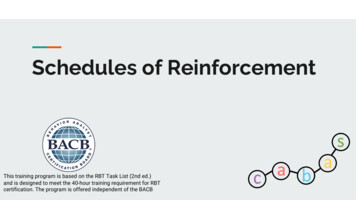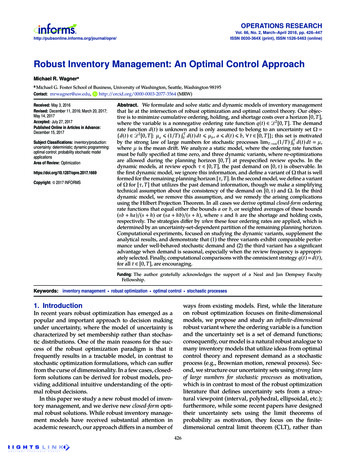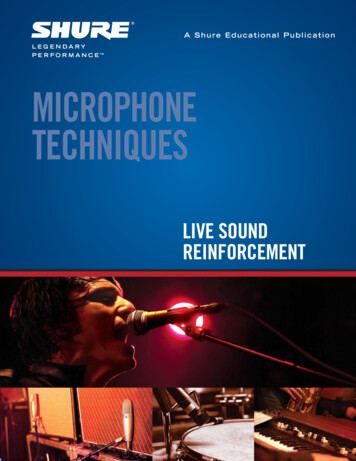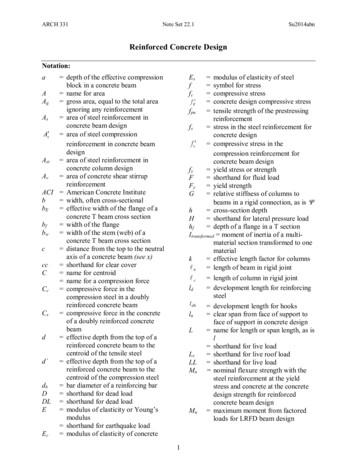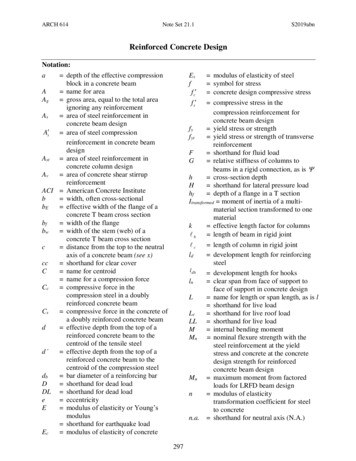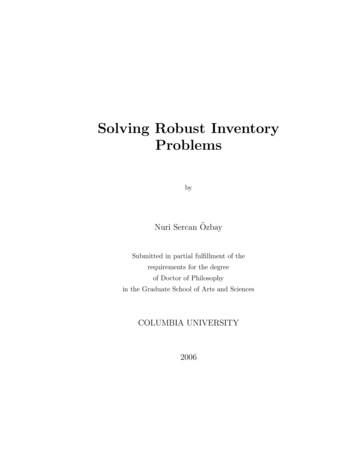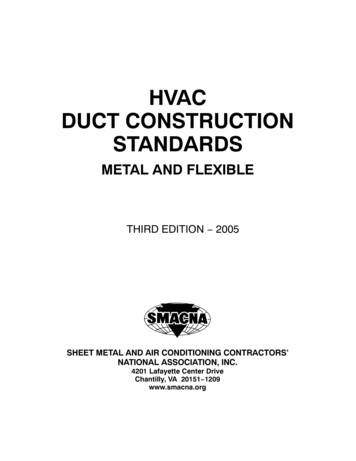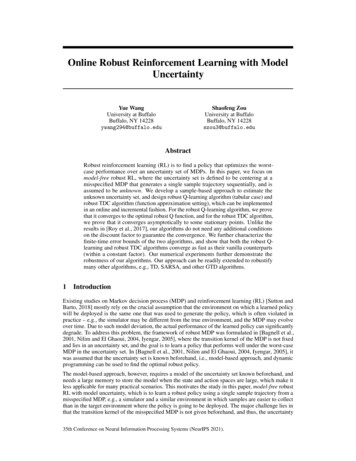
Transcription
Online Robust Reinforcement Learning with ModelUncertaintyYue WangUniversity at BuffaloBuffalo, NY 14228ywang294@buffalo.eduShaofeng ZouUniversity at BuffaloBuffalo, NY 14228szou3@buffalo.eduAbstractRobust reinforcement learning (RL) is to find a policy that optimizes the worstcase performance over an uncertainty set of MDPs. In this paper, we focus onmodel-free robust RL, where the uncertainty set is defined to be centering at amisspecified MDP that generates a single sample trajectory sequentially, and isassumed to be unknown. We develop a sample-based approach to estimate theunknown uncertainty set, and design robust Q-learning algorithm (tabular case) androbust TDC algorithm (function approximation setting), which can be implementedin an online and incremental fashion. For the robust Q-learning algorithm, we provethat it converges to the optimal robust Q function, and for the robust TDC algorithm,we prove that it converges asymptotically to some stationary points. Unlike theresults in [Roy et al., 2017], our algorithms do not need any additional conditionson the discount factor to guarantee the convergence. We further characterize thefinite-time error bounds of the two algorithms, and show that both the robust Qlearning and robust TDC algorithms converge as fast as their vanilla counterparts(within a constant factor). Our numerical experiments further demonstrate therobustness of our algorithms. Our approach can be readily extended to robustifymany other algorithms, e.g., TD, SARSA, and other GTD algorithms.1IntroductionExisting studies on Markov decision process (MDP) and reinforcement learning (RL) [Sutton andBarto, 2018] mostly rely on the crucial assumption that the environment on which a learned policywill be deployed is the same one that was used to generate the policy, which is often violated inpractice – e.g., the simulator may be different from the true environment, and the MDP may evolveover time. Due to such model deviation, the actual performance of the learned policy can significantlydegrade. To address this problem, the framework of robust MDP was formulated in [Bagnell et al.,2001, Nilim and El Ghaoui, 2004, Iyengar, 2005], where the transition kernel of the MDP is not fixedand lies in an uncertainty set, and the goal is to learn a policy that performs well under the worst-caseMDP in the uncertainty set. In [Bagnell et al., 2001, Nilim and El Ghaoui, 2004, Iyengar, 2005], itwas assumed that the uncertainty set is known beforehand, i.e., model-based approach, and dynamicprogramming can be used to find the optimal robust policy.The model-based approach, however, requires a model of the uncertainty set known beforehand, andneeds a large memory to store the model when the state and action spaces are large, which make itless applicable for many practical scenarios. This motivates the study in this paper, model-free robustRL with model uncertainty, which is to learn a robust policy using a single sample trajectory from amisspecified MDP, e.g., a simulator and a similar environment in which samples are easier to collectthan in the target environment where the policy is going to be deployed. The major challenge lies inthat the transition kernel of the misspecified MDP is not given beforehand, and thus, the uncertainty35th Conference on Neural Information Processing Systems (NeurIPS 2021).
set and the optimal robust policy need to be learned simultaneously using sequentially observed datafrom the misspecified MDP. Moreover, robust RL learns the value function of the worst-case MDPin the uncertainty set which is different from the misspecified MDP that generates samples. This issimilar to the off-policy learning, which we refer to as the "off-transition-kernel" setting. Therefore,the learning may be unstable and could diverge especially when function approximation is used[Baird, 1995].In this paper, we develop a model-free approach for robust RL with model uncertainty. Our majorcontributions in this paper are summarized as follows. Motivated by empirical studies of adversarial training in RL [Huang et al., 2017, Kos and Song,2017, Lin et al., 2017, Pattanaik et al., 2018, Mandlekar et al., 2017] and the R-contamination modelin robust detection (called -contamination model in [Huber, 1965]), we design the uncertainty setusing the R-contamination model (see (4) for the details). We then develop an approach to estimatethe unknown uncertainty set using only the current sample, which does not incur any additionalmemory cost. Unlike the approach in [Roy et al., 2017], where the uncertainty set is relaxed to onenot depending on the misspecified MDP that generates samples so that an online algorithm can beconstructed, our approach does not need to relax the uncertainty set. We develop a robust Q-learning algorithm for the tabular case, which can be implemented in anonline and incremental fashion, and has the same memory cost as the vanilla Q-learning algorithm.We show that our robust Q-learning algorithm converges asymptotically, and further characterizeits finite-time error bound. Unlike the results in [Roy et al., 2017] where a stringent conditionon the discount factor (which is due to the relaxation of the uncertainty set, and prevents the useof a discount factor close to 1 in practice) is needed to guarantee the convergence, our algorithmconverges without the need of such condition. Furthermore, our robust Q-learning algorithmconverges as fast as the vanilla Q-learning algorithm [Li et al., 2020] (within a constant factor),while being robust to model uncertainty. We generalize our approach to the case with function approximation (for large state/action space).We investigate the robust policy evaluation problem, i.e., evaluate a given policy under the worstcase MDP in the uncertainty set. As mentioned before, the robust RL problem is essentially"off-transition-kernel", and therefore non-robust methods with function approximation may diverge[Baird, 1995] (also see our experiments). We develop a novel extension of the gradient TD (GTD)method [Maei et al., 2010, Maei, 2011, Sutton et al., 2008] to robust RL. Our approach introduces anovel smoothed robust Bellman operator to construct the smoothed mean-squared projected robustBellman error (MSPRBE). Using our uncertainty set design and online sample-based estimation,we develop a two time-scale robust TDC algorithm. We further characterize its convergence andfinite-time error bound. We conduct numerical experiments to validate the robustness of our approach. In our experiments,our robust Q-learning algorithm achieves a much higher reward than the vanilla Q-learning algorithm when being trained on a misspecified MDP; and our robust TDC algorithm converges muchfaster than the vanilla TDC algorithm, and the vanilla TDC algorithm may even diverge.1.1Related WorkModel-Based Robust MDP. The framework of robust MDP was investigated in [Iyengar, 2005,Nilim and El Ghaoui, 2004, Bagnell et al., 2001, Satia and Lave Jr, 1973, Wiesemann et al., 2013],where the transition kernel is assumed to be in some uncertainty set, and the problem can be solved bydynamic programming. This approach was further extended to the case with function approximationin [Tamar et al., 2014]. However, these studies are model-based, which assume beforehand knowledgeof the uncertainty set. In this paper, we investigate the model-free setting, where the uncertainty set isa set of MDPs centered around some unknown Markov transition kernel from which a single sampletrajectory can be sequentially observed.Adversarial Robust RL. It was shown in [Iyengar, 2005] that the robust MDP problem is equivalentto a zero-sum game between the agent and the nature. Motivated by this fact, the adversarial trainingapproach, where an adversary perturbs the state transition, was studied in [Vinitsky et al., 2020, Pintoet al., 2017, Abdullah et al., 2019, Hou et al., 2020, Rajeswaran et al., 2017, Atkeson and Morimoto,2003, Morimoto and Doya, 2005]. This method relies on a simulator, where the state transition canbe modified in an arbitrary way. Another approach is to modify the current state through adversarial2
samples, which is more heuristic, e.g., [Huang et al., 2017, Kos and Song, 2017, Lin et al., 2017,Pattanaik et al., 2018, Mandlekar et al., 2017]. Despite the empirical success of these approaches,theoretical performance guarantees, e.g., convergence to the optimal robust policy and convergencerate, are yet to be established. The main difference lies in that during the training, our approach doesnot need to manipulate the state transition of the MDP. More importantly, we develop the asymptoticconvergence to the optimal robust policy and further characterize the finite-time error bound. In [Limet al., 2013], the scenario where some unknown parts of the state space can have arbitrary transitionswhile other parts are purely stochastic was studied. Adaptive algorithm to adversarial behavior wasdesigned, and its regret bound is shown to be similar to the purely stochastic case. In [Zhang et al.,2020a], the robust adversarial RL problem for the special linear quadratic case was investigated.Model-free Robust RL. In [Roy et al., 2017, Badrinath and Kalathil, 2021] model-free RL withmodel uncertainty was studied, where in order to construct an algorithm that can be implemented in anonline and incremental fashion, the uncertainty set was firstly relaxed by dropping the dependency onthe misspecified MDP that generates the samples (centroid of the uncertainty set). Such a relaxationis pessimistic since the relaxed uncertainty set is not centered at the misspecified MDP anymore(which is usually similar to the target MDP), making the robustness to the relaxed uncertainty setnot well-justified. Such a relaxation will further incur a stringent condition on the discounted factorto guarantee the convergence, which prevents the use of a discount factor close to 1 in practice.Moreover, only asymptotic convergence was established in [Roy et al., 2017]. In this paper, we donot relax the uncertainty set, and instead propose an online approach to estimate it. Our algorithmsconverge without the need of the condition on the discount factor. We also provides finite-time errorbounds for our algorithms. The multi-agent RL robust to reward uncertainty was investigated in[Zhang et al., 2020b], where the reward uncertainty set is known, but the transition kernel is fixed.Finite-time Error Bound for RL Algorithms. For the tubular case, Q-learning has been studiedintensively, e.g., in [Even-Dar et al., 2003, Beck and Srikant, 2012, Qu and Wierman, 2020, Li et al.,2020, Wainwright, 2019, Li et al., 2021]. TD with function approximation were studied in [Dalal,Gal and Szörényi, Balázs and Thoppe, Gugan and Mannor, Shie, 2018, Bhandari et al., 2018, Srikantand Ying, 2019, Cai et al., 2019, Sun et al., 2020]. Q-learning and SARSA with linear functionapproximation were investigated in [Zou et al., 2019, Chen et al., 2019]. The finite-time error boundsfor the gradient TD algorithms [Maei et al., 2010, Sutton et al., 2009, Maei et al., 2010] were furtherdeveloped recently in [Dalal et al., 2018, Liu et al., 2015, Gupta et al., 2019, Xu et al., 2019, Dalalet al., 2020, Kaledin et al., 2020, Ma et al., 2020, Wang and Zou, 2020, Ma et al., 2021, Doan, 2021].There are also finite-time error bounds on the policy gradient methods and actor critic methods, e.g.,[Wang et al., 2020, Yang et al., 2019, Kumar et al., 2019, Qiu et al., 2019, Wu et al., 2020, Cenet al., 2020, Bhandari and Russo, 2019, Agarwal et al., 2021, Mei et al., 2020]. We note that thesestudies are for the non-robust RL algorithms, and in this paper, we design robust RL algorithms, andcharacterize their finite-time error bounds.2PreliminariesMarkov Decision Process. An MDP can be characterized by a tuple (S, A, P, c, γ), where S and Aare the state and action spaces, P pas S , a A, s S is the transition kernel1 , c is the costfunction, and γ [0, 1) is the discount factor. Specifically, pas denotes the distribution of the nextstate if taking action a at state s. Let pas {pas,s0 }s0 S , where pas,s0 denotes the probability that theenvironment transits to state s0 if taking action a at state s. The cost of taking action a at state s isgiven by c(s, a). A stationary policy π is a mapping from S to a distribution over A. At each timet, an agent takes an action At A at state St S. The environment then transits to the next statetSt 1 with probability pASt ,St 1 , and the agent receives cost given by c(St , At ). The value function ofa policy π starting fromP any initial state s S is defined as the expected accumulated discounted costby following π: E [ t 0 γ t c(St , At ) S0 s, π], and the goal is to find the policy π that minimizesthe above value function for any initial state s S.Robust Markov Decision Process. In the robust case, the transition kernel is not fixed and lies insome uncertainty set. Denote the transition kernel at time t by Pt , and let κ (P0 , P1 , .), wherePt P, t 0, and P is the uncertainty set of the transition kernel. The sequence κ can be viewedas the policy of the nature, and is adversarially chosen by the nature [Bagnell et al., 2001, Nilim and1 n denotes the (n 1)-dimensional probability simplex: {(p1 , ., pn ) 0 pi 1,3Pni 1pi 1}.
El Ghaoui, 2004, Iyengar, 2005]. Define the robust value function of a policy π as the worst-caseexpected accumulated discounted cost following a fixed policy π over all transition kernels in theuncertainty set:" #XπtV (s) max Eκγ c(St , At ) S0 s, π ,(1)κt 0where Eκ denotes the expectation when the state transits accordingP to κ. Similarly, define the robustaction-value function for a policy π: Qπ (s, a) maxκ Eκ [ t 0 γ t c(St , At ) S0 s, A0 a, π] .The goal of robust RL is to find the optimal robust policy π that minimizes the worst-case accumulated discounted cost:π arg min V π (s), s S.π (2) We also denote V π and Qπ by V and Q , respectively, and V (s) mina A Q (s, a).Note that a transition kernel is a collection of conditional distributions. Therefore, the uncertainty setP of the transition kernel can be equivalently written as a collection of Pas for all s S, a A, wherePas is a set of conditional distributions pas over the state space S. Denote by σP (v) , maxp P (p v)the support function of vector v over a set of probability distributions P. For robust MDP, thefollowing robust analogue of the Bellman recursion was provided in [Nilim and El Ghaoui, 2004,Iyengar, 2005].Theorem 1. [Nilim and El Ghaoui, 2004] The following perfect duality condition holds for all s S:" #" #XXttmin max Eκγ c(St , At ) π, S0 s max min Eκγ c(St , At ) π, S0 s .(3)πκκt 0 πt 0 The optimal robust value function V satisfies V (s) mina A (c(s, a) γσPas (V )), and theoptimal robust action-value function Q satisfies Q (s, a) c(s, a) γσPas (V ).Define the robust Bellman operator T by TQ(s, a) c(s, a) γσPas (mina A Q(s, a)). It wasshown in [Nilim and El Ghaoui, 2004, Iyengar, 2005] that T is a contraction and its fixed point is theoptimal robust Q . When the uncertainty set is known, so that σPas can be computed exactly, V andQ can be solved by dynamic programming [Iyengar, 2005, Nilim and El Ghaoui, 2004].3R-Contamination Model For Uncertainty Set ConstructionIn this section, we construct the uncertainty set using the R-contamination model.Let P {pas , s S, a A} be the centroid of the uncertainty set, i.e., the transition kernel thatgenerates the sample trajectory, and P is unknown. For example, P can be the simulator at hand,which may not be exactly accurate; and P can be the transition kernel of environment 1, from whichwe can take samples to learn a policy that will be deployed in a similar environment 2. The goal is tolearn a policy using samples from P that performs well when applied to a perturbed MDP from P.Motivated by empirical studies of adversarial training in RL [Huang et al., 2017, Kos and Song, 2017,Lin et al., 2017, Pattanaik et al., 2018, Mandlekar et al., 2017] and the R-contamination model inrobust detection [Huber, 1965], we use the R-contamination model to define the uncertainty set: Pas (1 R)pas Rq q S , s S, a A, for some 0 R 1.(4)Here, pas is the centroid of the uncertainty set Pas at (s, a), which is unknown, and R is the designparameter of the uncertainty set, which measuresthe size of the uncertainty set, and is assumed to beNknown in the algorithm. We then let P s S,a A Pas .Remark 1. R-contamination model is closely related to other uncertainty set models like total variation and KL-divergence.It can be shown that R-contaminationset certered at p is a subset of total variation ball : (1 R)p Rq q S q S dTV (p, q) R . Hence the total variation uncertainty set is less conservative than our R-contamination uncertainty set. KL-divergenceqmoreover can be related to total variation using Pinsker’s inequality, i.e., dTV (p, q) 12 dKL (p, q).4
4Tabular Case: Robust Q-LearningIn this section, we focus on the tabular case with finite state and action spaces. We focus on theasynchronous setting where a single sample trajectory is available with Markovian noise. We willdevelop an efficient approach to estimate the unknown uncertainty set P, and further the supportfunction σPas (·), and then design our robust Q-learning algorithm.We propose an efficient and data-driven approach to estimate the unknown pas and thus the unknownuncertainty set Pas for any s S and a A. Specifically, denote the sample at t-th time step byOt (st , at , st 1 ). We then use Ot to obtain the maximum likelihood estimate (MLE) p̂t , 1st 1of the transition kernel pastt , where 1st 1 is a probability distribution taking probability 1 at st 1and 0 at other states. This is an unbiased estimate of the transition kernel pastt conditioning on St st and At at . We then design a sample-based estimate P̂t , (1 R)p̂t Rq q S of the uncertainty set Pastt . Using the sample-based uncertainty set P̂t , we construct the followingrobust Q-learning algorithm in Algorithm 1. For any t, σP̂t (Vt ) can be easily computed: σP̂t (Vt ) Algorithm 1 Robust Q-LearningInitialization: T , Q0 (s, a) for all (s, a) S A, behavior policy πb , s0 , step size αt1: for t 0, 1, 2, ., T 1 do2:Choose at according to πb (· st )3:Observe st 1 and ct4:Vt (s) mina A Qt (s, a), s S5:Qt 1 (st , at ) (1 αt )Qt (st , at ) αt (ct γσP̂t (Vt ))6:Qt 1 (s, a) Qt (s, a) for (s, a) 6 (st , at )7: end forOutput: QTR maxs S Vt (s) (1 R)Vt (st 1 ). Hence the update in Algorithm 1 (line 5) can be written asQt 1 (st , at ) (1 αt )Qt (st , at ) αt (ct γR max Vt (s) γ(1 R)Vt (st 1 )).s S(5)Compared to the model-based approach, our approach is model-free. It does not require the priorknowledge of the uncertainty set, i.e., the knowledge of pas , s S, a A. Furthermore, thememory requirement of our algorithm is S A (used to store the Q-table), and unlike the modelbased approach it does not need a table of size S 2 A to store pas , s S, a A, which could beproblematic if the state space is large. Moreover, our algorithm does not involve a relaxation of theuncertainty set like the one in [Roy et al., 2017], which will incur a stringent condition on the discountfactor to guarantee the convergence. As will be shown below, the convergence of our Algorithm 1does not require any condition on the discount factor.We show in the following theorem that the robust Q-learning algorithm converges asymptotically tothe optimal robust action-value function Q .P P Theorem 2. (Asymptotic Convergence) If step sizes αt satisfy that t 0 αt and t 0 αt2 ,then Qt Q as t with probability 1.To further establish the finite-time error bound for our robust Q-learning algorithm in Algorithm 1,we make the following assumption that is commonly used in the analysis of vanilla Q-learning.Assumption 1. The Markov chain induced by the behavior policy πb and the transition kernelpas , s S, a A is uniformly ergodic.Let µπb denote the stationary distribution over S A induced by πb and pas , s S, a A. Wethen further define µmin min(s,a) S A µπb (s, a). This quantity characterizes how many samplesare needed to visit every state-action pair sufficiently often. Define the following mixing time ofthe induced Markov chain: tmix min t : maxs S dTV (µπ , P (st · s0 s)) 14 , where dTVis the total variation distance.The following theorem establishes the finite-time error bound of our robust Q-learning algorithm.5
Theorem 3. (Finite-Time Error Bound) There exist some positive constants c0 and c1 such that for1any δ 1, any 1 γ, any T satisfying tmix1T S A 1T c0 ,(6)loglogµmin (1 γ)5 2µmin (1 γ)δ (1 γ)2 24c11 (1 γ), γ2, t 0 we have with probability at least 1 6δ,and step size αt min tmixT S A log()δkQT Q k 3 .1From the theorem, we can see that to guarantee an -accurate estimate, a sample size Õ( µmin (1 γ)5 2 tmixµmin (1 γ) ) (up to some logarithmic terms) is needed. This complexity matches with the one for thevanilla Q-learning in [Li et al., 2020] (within a constant factor), while our algorithm also guaranteesrobustness to MDP model uncertainty. Our algorithm design and analysis can be readily extendedto robustify TD and SARSA. The variance-reduction technique [Wainwright, 2019] can also becombined with our robust Q-learning algorithm to further improve the dependency on (1 γ).5Function Approximation: Robust TDCIn this section, we investigate the case where the state and action spaces can be large or evencontinuous. A popular approach is to approximate the value function using a parameterized function,e.g., linear function and neural network. In this section, we focus on the case with linear functionapproximation to illustrate the main idea of designing robust RL algorithms. Our approach can beextended to non-linear (smooth) function approximation using techniques in, e.g., [Cai et al., 2019,Bhatnagar et al., 2009, Wai et al., 2019, Wang et al., 2021].We focus on the problem of robust policy evaluation, i.e., estimate the robust value function V πdefined in (1) for a given policy π under the worst-case MDP transition kernel in the uncertainty set.Note that for robust RL with model uncertainty, any policy evaluation problem can be viewed as"off-transition-kernel", as it is to evaluate the value function under the worst-case MDP using samplesfrom a different MDP. Since the TD algorithm with function approximation may diverge underoff-policy training [Baird, 1995] and importance sampling cannot be applied here due to unknowntransition kernel, in this paper we generalize the GTD method [Maei et al., 2010, Maei, 2011] to therobust setting. Let φ(i) : S R, i 1, . . . , N be a set of N fixed base functions, where N S A . Inparticular, we approximate the robust value function using a linear combination of φ(i) ’s: Vθ (s) PN i (i) Ni 1 θ φs φs θ, where θ R is the weight vector.Define the following robust Bellman operator for a given policy π:Tπ V (s) , EA π(· s) [c(s, A) γσPA(V )]s" EA π(· s) c(s, A) γ(1 R)#XpAs,s0 V00(s ) γR maxV (s ) .0s0 Ss S(7)We then define the mean squared projected robust Bellman error (MSPRBE) as2MSPRBE(θ) kΠTπ Vθ Vθ kµπ ,(8)where kvk2µπ v 2 (s)µπ (ds), µπ is the stationary distribution induced by π, and Π is a projectiononto the linear function space w.r.t. k · kµπ . We will develop a two time-scale gradient-based approachto minimize the MSPRBE. However, it can be seen that maxs Vθ (s) in (7) is not smooth in θ, whichis troublesome in both algorithm design and analysis. To solve this issue, we introduce the followingsmoothed robust Bellman operator T̂π by smoothing the max with a LSE(LogSumExp):"#XA0T̂π V (s) EA π(· s) c(s, A) γ(1 R)ps,s0 V (s ) γR · LSE(V ) ,(9)Rs0 S6
where LSE(V ) log(Pe%V (s) )%sis the LogSumExp w.r.t. V with a parameter % 0. Note that when% , the smoothed robust Bellman operator T̂π Tπ . The LSE operator can also be replacedby some other operator that approximates the max operator and is smooth, e.g., mellow-max [Asadiand Littman, 2017]. In the following, we first show that the fixed point of T̂π exists for any %, andthe fixed points converge to the one of Tπ for large %.Theorem 4. (1). For any %, T̂π has a fixed point.(2). Let V1 and V2 be the fixed points of T̂π and Tπ , respectively. ThenkV1 V2 k γR log S 0, as % .1 γ %(10)We then denote by J(θ) the smoothed MSPRBE with the LSE operator, and the goal is:2min J(θ) min ΠT̂π Vθ Vθθ5.1θ.µπ(11)Algorithm DevelopmentIn the following, we develop the robust TDC algorithm to solve the problem in (11). We willfirst derive the gradient of the smoothed MSPRBE, J(θ), and then design a two time-scaleupdate rule using the weight doubling trick in [Sutton et al., 2009] to solve the double sampling problem. Define δs,a,s0 (θ) , c(s, a) γ(1 R)Vθ (s0 ) γRLSE(Vθ ) θ (s), V where LSE(Vθ ) is the LogSumExp function w.r.t. Vθ θ φ. Denote by C , Eµπ φS φS . Then,Eµ [δS,A,S 0 (θ)φS ] Φ D T̂π Vθ Vθ , where D diag(µπ (s1 ), µπ (s2 ), ., µπ (s S )) andΦ (φs1 , φs2 , ., φs S ) R S N . We know that Π DΠ D Φ(Φ DΦ) 1 Φ D from [Maei,2011]. Hence we have2J(θ) ΠT̂π Vθ Vθµπ Eµπ [δS,A,S 0 (θ)φS ] C 1 Eµπ [δS,A,S 0 (θ)φS ].(12)Then, its gradient can be written as:1 J(θ) Eµπ [( δS,A,S 0 (θ))φS ] C 1 Eµπ [δS,A,S 0 (θ)φS ]2 Eµπ [δS,A,S 0 (θ)φS ] γEµπ (1 R)φS 0 R · LSE(Vθ ) φ S ω(θ),where ω(θ) C 1 Eµπ [δS,A,S 0 (θ)φS ]. It can be seen that to obtain an unbiased estimate of J(θ),two independent samples are needed as there exists a multiplication of two expectations, which isnot applicable when there is only one sample trajectory. We then utilize the weight doubling trick in[Sutton et al., 2009], and design the robust TDC algorithm in Algorithm 2. Specifically, we introducea fast time scale to estimate ω(θ), and a slow time scale to estimate J(θ). Denote the projection byΠK (x) , arg minkyk K ky xk for any x RN . Our robust TDC algorithm in Algorithm 2 canbe implemented in an online and incremental fashion. If the uncertainty set becomes a singleton, i.e.,R 0, then Algorithm 2 reduces to the vanilla TDC algorithm.5.2Finite-Time Error Bound of Robust TDCUnlike the vanilla TDC algorithm, J(θ) here is non-convex. Therefore, we are interested in theconvergence to stationary points, i.e., the rate of k J(θ)k 0. We first make some standardassumptions which are commonly used in RL algorithm analysis, e.g., [Wang and Zou, 2020, Kaledinet al., 2020, Xu et al., 2019, Srikant and Ying, 2019, Bhandari et al., 2018].Assumption 2 (Bounded feature). kφs k2 1, s S.Assumption 3 (Bounded cost function). c(s, a) cmax , s S and a A.Assumption 4 (Problem solvability). The matrix C Eµπ [φS φ S ] is non-singular with λ 0 beingits smallest eigenvalue.7
Algorithm 2 Robust TDC with Linear Function ApproximationInput: T ,α, β, %, φi for i 1, ., N , projection radius KInitialization: θ0 ,w0 , s01: Choose W Uniform(0, 1, ., T 1)2: for t 0, 1, 2, ., W 1 do3:Take action according to π(· st ) and observe st 1 and ct4:φt φs t5:6:log(Pe%θ φs)s Vθt (st )δt (θt ) ct γ(1 R)Vθt (st 1 ) γR% Pe%Vθ (s) φs Pθt 1 ΠK θt α δt (θt )φt γ (1 R)φt 1 Rφt ωte%Vθ (j)s S7:ωt 1 ΠK (ωt β(δt (θt ) 8: end forj Sφ t ωt )φt )Output: θWAssumption 5 (Geometric uniform ergodicity). There exist some constants m 0 and ρ (0, 1)such that for any t 0, maxs S dTV (P(st s0 s), µπ ) mρt .In the following theorem, we characterize the finite-time error bound for the convergence of ourrobust TDC algorithm. Here we only provide the order of the bounds in terms of T . The explicitbounds can be found in (129) in Appendix D.3. Theorem 5. Consider the following step-sizes: β O T1b , and α O T1a , where 12 a 1and 0 b a. Then we have that 112 α log(1/α) β log(1/β) ,(13)E[k J(θW )k ] OTαTβ T .If we further let a b 0.5, then E[k J(θW )k2 ] O logTThe robust TDC has a matching complexity with the vanilla TDC with non-linear function approximation [Wang et al., 2021], but provides the additional robustness to model uncertainty. It does notneed to relax the uncertainty set like in [Roy et al., 2017], and our convergence results do not need acondition on the discount factor.66.1ExperimentsRobust Q-LearningIn this section, we compare our robust Q-learning with the vanilla non-robust Q-learning. We useOpenAI gym framework [Brockman et al., 2016], and consider two different problems: Frozen lakeand Cart-Pole. One more example of the taxi problem is given in the appendix. To demonstrate therobustness, the policy is learned in a perturbed MDP, and is then tested on the true unperturbed MDP.Specifically, during the training, we set a probability p such that after the agent takes an action, withprobability p, the state transition is uniformly over S, and with probability 1 p the state transitionis according to the true unperturbed transition kernel. The behavior policy for all the experiments1below is set to be a uniform distribution over the action space given any state, i.e., πb (a s) A forany s S and a A. We then evaluate the performance of the obtained policy in the unperturbedenvironment. At each time t, the policy we evaluate is the greedy-policy w.r.t. the current estimate ofthe Q-function, i.e., πt (s) arg maxa Qt (s, a). A Monte-Carlo method with horizon 100 is used toevaluate the accumulated discounted reward of the learned policy on the unperturbed MDP. We takethe average over 30 trajectories. More details are provided in the appendix.In Figure 1 and Figure 2, we plot the accumulated discounted reward of both algorithms underdifferent p an
unknown uncertainty set, and design robust Q-learning algorithm (tabular case) and robust TDC algorithm (function approximation setting), which can be implemented in an online and incremental fashion. For the robust Q-learning algorithm, we prove that it converges to the opt

